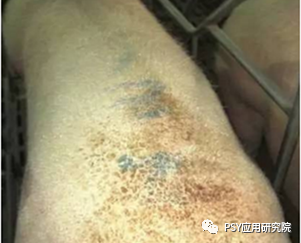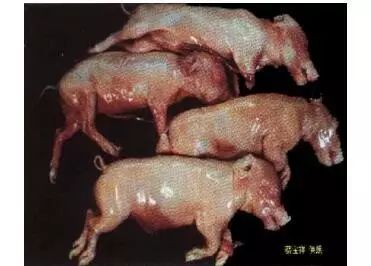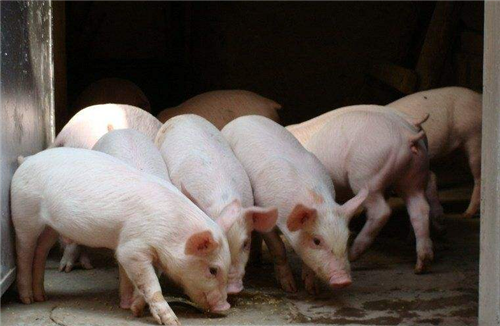The sow's leg is soft and its feet are cracked. Have you found the reason?
Cracked hoof disease occurs in some scale pig farms after autumn every year, especially from October and November, and it is the most serious in December. Sows with good growth performance, such as Xinmei and Xindan Landrace, are more likely to occur. According to the intuition of front-line pig farm managers, these split-hoof pigs are biotin deficient.
Here, I would like to express a point of view: biotin deficiency can cause cracked hooves, but cracked hooves are not necessarily caused by biotin deficiency.
Stress and pain caused by lameness can damage the reproductive physiology of animals and prevent sows from estrus and pregnancy. During artificial insemination, pain may interfere with the release of oxytocin, affecting uterine contraction and the efficient transport of sperm to the fertilization site. Lame sows are reluctant to stand up to feed and drink, which can further lead to physical decline, urethral and external reproductive organ infections, and reproductive disorders.
In addition, crippled sows are at high risk of killing their piglets before weaning (Defra,2005). Due to lameness, the agility of sows decreased, the ability to move away from piglets in danger and the ability to respond quickly to painful cries of piglets due to squeeze were reduced.
In addition to reproductive disorders, lameness is the second leading cause of elimination of immature sows, and the proportion of the first and second parturient sows eliminated for this reason is about 16% 17% (Dagorn et al., 1979, Shenzhen, 39, Allaire, 1987, Dijkhuizen, 1989, Stein, 1990, Lucia, 2000). In a survey of farm records (Boyle et al. 1998), it was found that dyskinesia sows accounted for nearly 32% of all first-born sows eliminated!

Fig. 1 biotin deficiency dermatitis (dry, flaky, fish scaly skin)
Fig. 2 foot cleft caused by biotin deficiency
What is the cause of leg soft hoof crack?
1. Variety
◆ lean meat type varieties and strains such as Xinmei, Xindan Landrace, Yorkshire, Duroc and Hampshire are more likely to occur.
Pigs with slender ◆ limbs are most likely to suffer from the disease.
◆ Chinese local breeds and their crossbred offspring with foreign breeds seldom occur the disease.
2. Bone dysplasia
The main cause of leg weakness is bone dysplasia (breeding-rapid growth, high feed reward, thin backfat, ketone body length, high lean meat rate; sexual maturity at 5-6 months old, but the bone did not mature until 18 months old, and the adolescence of 6-18 months old is the period of bone dysplasia in pigs). During the cultivation period, the growth rate is too fast, and the protein (lysine) is too high.
3. Physiological stage
The nutrition of pregnant pigs in late pregnancy should be higher than that of breastfeeding, because they eat less 2.5kg (except energy).
4. Fence floor
◆ too smooth ground-when fed with liquid feed, the feed spilled onto the plastic floor contains high levels of soluble non-starch polysaccharides, which can make the surface of the plastic floor extremely dangerous, resulting in more leg injuries in live pigs.
◆ too rough ground-bruises-staphylococci and other breeding
The new cement floor made by ◆ has strong alkalinity.
◆ excessive use of some strongly alkaline disinfectant-strong alkaline (limewater, phenols, quaternary amine salts)-foot bottom corrosion-scab
5. Season
It is common for the weather to turn cool after autumn-- surface capillary contraction-- nutritional supply-- fragile hooves.
The adaptive regulation of pigs after autumn, the contraction of capillaries on the body surface, resulting in reduced secretion of lipids, hardening and brittleness of hooves, cracks, deficiency of calcium and phosphorus, imbalance of proportion and decrease of vitamin D synthesis in hoof disease.
6. Biotin deficiency
◆ biotin is widely distributed and can be synthesized by intestinal microorganisms, requiring less biotin, so deficiency is rare in both humans and animals. However, biotin deficiency can be induced by some antagonists.
◆ binds to biotin proteins such as damage to egg whites. Animals fed with unboiled egg whites can induce dermatitis and hair loss, and return to normal after biotin supplementation. The damage mainly involves abnormal lipid metabolism and energy production.
◆ antibiotic protein streptomycin and antibiotic protein nisin of some Streptomyces.
Metamorphic fatty acids in ◆ fish meal can destroy biotin, so it is easy to produce biotin deficiency when using inferior fish meal.
The high temperature environment of ◆ hinders the biosynthesis of biotin by intestinal bacteria.
◆ only part of the biotin can be used in certain grains (wheat bran, wheat, barley, sorghum) and animal-derived proteins (meat meal, poultry products processing by-products).
◆ feed is moldy and raw materials are oxidized and rancidity.
7. Mineral changes
◆ zinc deficiency is one of the main causes, zinc deficiency shows foot fissure or lateral fissure; (accompanied by rough fur)
Calcium and zinc antagonism of ◆-- quality and quantity of stone powder
Lack of calcium and phosphorus in ◆ or improper proportion, lack of VD is easy to cause foot crack.
Excessive fluoride in ◆, chronic fluorosis-CaF---- calcium deficiency and manganese deficiency can lead to abnormal deformation of limbs and hooves.
Lack of ◆ Mn-- mostly transverse cleft
◆ selenium deficiency can cause foot deformation (can be accompanied by depilation, arthritis, etc.)
Vitamins
The addition of vitamin C has a certain improvement-it is the premise that vitamin E and D play a role, and affects the synthesis of collagen-calcified incomplete split hoof.
9. Pharmaceutical additives
◆ Bata stimulants-resulting in low blood calcium, zinc and manganese levels-hindlimb weakness and claudication.
◆ nicotinamide, which can prevent the metabolic loss of minerals and trace elements to some extent, is the leg disease of ducks.
Prevention and control measures of cracked hoof
1. Seed selection
Avoid breeding pigs with long back, narrow waist, wide buttocks, short hind legs, tilted front legs, oblique ankles and small inner hooves.
2. Ground
Rough ground can be smoothed with bricks or machinery, moist
The newly built cement floor is disinfected with acid disinfectant for several times before use.
3. Exercise
Exercise once a week after 80kg; 90kg once every three days; 100kg once a day.
4. Sunshine
Light is not equal to sunlight, and the synthesis of vitamin D needs the assistance of ultraviolet rays to build a sunny pig house.
Fig. 3 A sunny pig house with transparent tiles on the roof
5. Nutrition
The nutrients related to the development of limb and hoof bones of ◆, such as calcium, phosphorus, biotin, zinc, manganese and vitamin D, need to be balanced, and the related nutrients should be dynamically managed and supplemented in pig farms under non-standard production conditions.
◆ biotin should not be less than 400mg per ton of formula feed; zinc 120g-250g (zinc source-organic zinc)
◆ needs to restrict feeding after the first estrus, and the physical development and sexual development need to be synchronized. For pig farms with fast growth and serious leg disease, the 60kg feeding time limit is 10%, 20% after proestrus, and 15 days before mating to make up for the negative effect of feed restriction on ovulation.
Treatment.
Soak in 0.1%KMnO4, chlortetracycline ointment or Vaseline + zinc sulfate + chlortetracycline
Verification effect of therapeutic diagnosis
Fig. 4 photos of occurrence (dry, flaky, scale-like skin)
Fig. 5 11 days after the addition of 500ppb biotin products to the pregnancy diet (the old fish scale dead skin fell off, revealing healthy pink skin)
Pregnancy diet supplemented with 500ppb biotin products for 30 days (full recovery, no visible fish scale skin)
Related
- On the eggshell is a badge full of pride. British Poultry Egg Market and Consumer observation
- British study: 72% of Britons are willing to buy native eggs raised by insects
- Guidelines for friendly egg production revised the increase of space in chicken sheds can not be forced to change feathers and lay eggs.
- Risk of delay in customs clearance Australia suspends lobster exports to China
- Pig semen-the Vector of virus Transmission (4)
- Pig semen-the Vector of virus Transmission (3)
- Five common causes of difficult control of classical swine fever in clinic and their countermeasures
- Foot-and-mouth disease is the most effective way to prevent it!
- PED is the number one killer of piglets and has to be guarded against in autumn and winter.
- What is "yellow fat pig"? Have you ever heard the pig collector talk about "yellow fat pig"?



